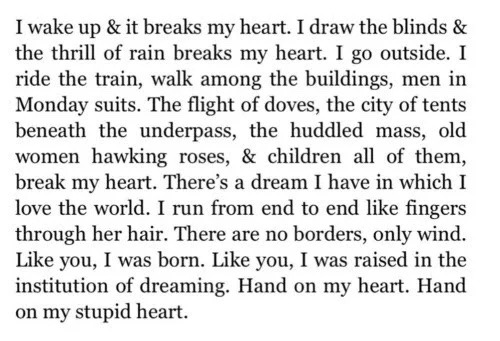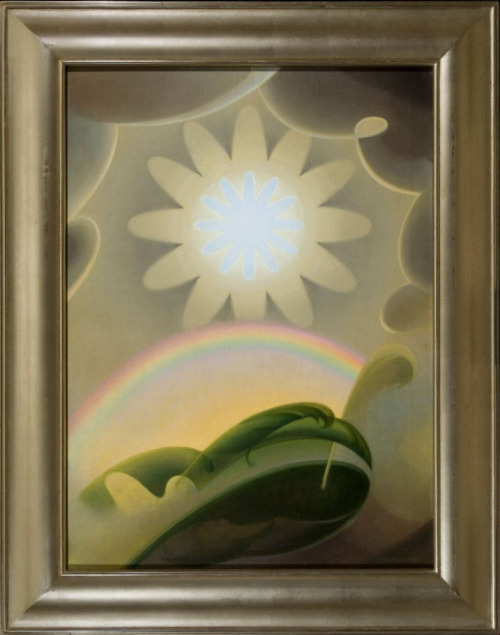“I Want Us To Be Doing Things, Prolonging Life’s Duties As Much As We Can. I Want Death To Find Me




“I want us to be doing things, prolonging life’s duties as much as we can. I want death to find me planting my cabbages, neither worrying about it nor the unfinished gardening.” ― Michel de Montaigne
More Posts from Thxsdad and Others
Hope posting
Song: The Orb of Dreamers by The Daniel Pemberton TV Orchestra
From Anthony Bourdain:
Americans love Mexican food. We consume nachos, tacos, burritos, tortas, enchiladas, tamales and anything resembling Mexican in enormous quantities. We love Mexican beverages, happily knocking back huge amounts of tequila, mezcal, and Mexican beer every year. We love Mexican people—we sure employ a lot of them.
Despite our ridiculously hypocritical attitudes towards immigration, we demand that Mexicans cook a large percentage of the food we eat, grow the ingredients we need to make that food, clean our houses, mow our lawns, wash our dishes, and look after our children.
As any chef will tell you, our entire service economy—the restaurant business as we know it—in most American cities, would collapse overnight without Mexican workers. Some, of course, like to claim that Mexicans are “stealing American jobs.”
But in two decades as a chef and employer, I never had ONE American kid walk in my door and apply for a dishwashing job, a porter’s position—or even a job as a prep cook. Mexicans do much of the work in this country that Americans, probably, simply won’t do.
We love Mexican drugs. Maybe not you personally, but “we”, as a nation, certainly consume titanic amounts of them—and go to extraordinary lengths and expense to acquire them. We love Mexican music, Mexican beaches, Mexican architecture, interior design, Mexican films.
So, why don’t we love Mexico?
We throw up our hands and shrug at what happens and what is happening just across the border. Maybe we are embarrassed. Mexico, after all, has always been there for us, to service our darkest needs and desires.
Whether it’s dress up like fools and get passed-out drunk and sunburned on spring break in Cancun, throw pesos at strippers in Tijuana, or get toasted on Mexican drugs, we are seldom on our best behavior in Mexico. They have seen many of us at our worst. They know our darkest desires.
In the service of our appetites, we spend billions and billions of dollars each year on Mexican drugs—while at the same time spending billions and billions more trying to prevent those drugs from reaching us.
The effect on our society is everywhere to be seen. Whether it’s kids nodding off and overdosing in small town Vermont, gang violence in L.A., burned out neighborhoods in Detroit—it’s there to see.
What we don’t see, however, haven’t really noticed, and don’t seem to much care about, is the 80,000 dead in Mexico, just in the past few years—mostly innocent victims. Eighty thousand families who’ve been touched directly by the so-called “War On Drugs”.
Mexico. Our brother from another mother. A country, with whom, like it or not, we are inexorably, deeply involved, in a close but often uncomfortable embrace.
Look at it. It’s beautiful. It has some of the most ravishingly beautiful beaches on earth. Mountains, desert, jungle. Beautiful colonial architecture, a tragic, elegant, violent, ludicrous, heroic, lamentable, heartbreaking history. Mexican wine country rivals Tuscany for gorgeousness.
It's archeological sites—the remnants of great empires, unrivaled anywhere. And as much as we think we know and love it, we have barely scratched the surface of what Mexican food really is. It is NOT melted cheese over tortilla chips. It is not simple, or easy. It is not simply “bro food” at halftime.
It is in fact, old—older even than the great cuisines of Europe, and often deeply complex, refined, subtle, and sophisticated. A true mole sauce, for instance, can take DAYS to make, a balance of freshly (always fresh) ingredients painstakingly prepared by hand. It could be, should be, one of the most exciting cuisines on the planet, if we paid attention.
The old school cooks of Oaxaca make some of the more difficult and nuanced sauces in gastronomy. And some of the new generation—many of whom have trained in the kitchens of America and Europe—have returned home to take Mexican food to new and thrilling heights.
It’s a country I feel particularly attached to and grateful for. In nearly 30 years of cooking professionally, just about every time I walked into a new kitchen, it was a Mexican guy who looked after me, had my back, showed me what was what, and was there—and on the case—when the cooks like me, with backgrounds like mine, ran away to go skiing or surfing or simply flaked. I have been fortunate to track where some of those cooks come from, to go back home with them.
To small towns populated mostly by women—where in the evening, families gather at the town’s phone kiosk, waiting for calls from their husbands, sons and brothers who have left to work in our kitchens in the cities of the North.
I have been fortunate enough to see where that affinity for cooking comes from, to experience moms and grandmothers preparing many delicious things, with pride and real love, passing that food made by hand from their hands to mine.
In years of making television in Mexico, it’s one of the places we, as a crew, are happiest when the day’s work is over. We’ll gather around a street stall and order soft tacos with fresh, bright, delicious salsas, drink cold Mexican beer, sip smoky mezcals, and listen with moist eyes to sentimental songs from street musicians. We will look around and remark, for the hundredth time, what an extraordinary place this is.

![Carroll Cloar, Moonstricken Girls, 1968 [Arkansas Museum Of Fine Arts Foundation Collection]](https://64.media.tumblr.com/460cac3507d0986220aebbf0b11c61a9/94a63df4f16b8c53-e9/s500x750/ff9fab256dc1c23a7638001b425db4d22b341450.jpg)
Carroll Cloar, Moonstricken Girls, 1968 [Arkansas Museum of Fine Arts Foundation Collection]

Olena Kalytiak Davis, Shattered Sonnets, Love Cards, and Other Off and Back Handed Importunities

Sharon Olds, True Love

Stephen Crane, In The Desert

Cameron Awkward-Rich, Meditations in an Emergency
ANTIGONE: The fields were wet. They were waiting for something to happen. The whole world was breathless, waiting. I can’t tell you what a roaring noise I seemed to make alone on the road. It bothered me that whatever was waiting, wasn’t waiting for me.
Jean Anouilh, Antigone

Etel Adnan, The Spring Flowers Own & The Manifestations of the Voyage
I’m trying to give you everything I have. But I can’t find it; I can’t find it yet.
Alice Notley, In The Pines

Anne Carson, Plainwater: Essays and Poetry
& if I were to forgive you (& I know I could)
who would be left
who would be left
to forgive me?
Hieu Minh Nguyen, Afterwards

Mahmoud Darwish, Mural

Fariha Róisín, How to Cure a Ghost
“You kiss the back of my legs and I want to cry. Only / the sun has come this close, only the sun.”
Shauna Barbosa, GPS

Mahmoud Darwish, Mural

Forough Farrokhzad, Another Birth
repetition in poetry // part i








Roberto Burle Marx
Burle Marx’s most famed completed commission in the U.S. was Miami’s vast, mosaic-embedded Biscayne Boulevard (1988–2004).
The Brazilian landscape architect Roberto Burle Marx (1909–1994) worked in a variety of artistic mediums, from painting and sculpture to graphic design and mosaics.
Keep reading


Björk 1993
Photographed by Sheridan Morley

Tyler the Creator, 2021
Ol' Dirty Bastard, 1995




Agnes Pelton (American, 1881–1961)
The Blest, n.d.
The Fountains, 1926
Sand Storm, 1932
Memory, 1937
More on hideback

Adam Burke
Capri Noctis, 2018
Acrylic on woood
my favorite part about not doing anything ever is
-
 dumbasshoyo reblogged this · 1 month ago
dumbasshoyo reblogged this · 1 month ago -
 impluvia liked this · 1 month ago
impluvia liked this · 1 month ago -
 stalekoolaidx liked this · 1 month ago
stalekoolaidx liked this · 1 month ago -
 wombwound23 liked this · 1 month ago
wombwound23 liked this · 1 month ago -
 thenightlymirror liked this · 1 month ago
thenightlymirror liked this · 1 month ago -
 tropicalmalady liked this · 1 month ago
tropicalmalady liked this · 1 month ago -
 sscullysglasses reblogged this · 1 month ago
sscullysglasses reblogged this · 1 month ago -
 youknowwobbles liked this · 1 month ago
youknowwobbles liked this · 1 month ago -
 adriantripods reblogged this · 1 month ago
adriantripods reblogged this · 1 month ago -
 adriantripods liked this · 1 month ago
adriantripods liked this · 1 month ago -
 heretopasstimebi liked this · 1 month ago
heretopasstimebi liked this · 1 month ago -
 nattvvi liked this · 1 month ago
nattvvi liked this · 1 month ago -
 nattvvi reblogged this · 1 month ago
nattvvi reblogged this · 1 month ago -
 daytrader-vader liked this · 1 month ago
daytrader-vader liked this · 1 month ago -
 go-out-of-wonderland liked this · 1 month ago
go-out-of-wonderland liked this · 1 month ago -
 charlottie4 liked this · 1 month ago
charlottie4 liked this · 1 month ago -
 drinkthemlock reblogged this · 1 month ago
drinkthemlock reblogged this · 1 month ago -
 allpurposelesbian liked this · 1 month ago
allpurposelesbian liked this · 1 month ago -
 cattyycat reblogged this · 1 month ago
cattyycat reblogged this · 1 month ago -
 thequietabsolute liked this · 1 month ago
thequietabsolute liked this · 1 month ago -
 lovrcide liked this · 1 month ago
lovrcide liked this · 1 month ago -
 priv0123 reblogged this · 1 month ago
priv0123 reblogged this · 1 month ago -
 jazbina reblogged this · 1 month ago
jazbina reblogged this · 1 month ago -
 jazbina liked this · 1 month ago
jazbina liked this · 1 month ago -
 pettydemon reblogged this · 1 month ago
pettydemon reblogged this · 1 month ago -
 saintshiv liked this · 1 month ago
saintshiv liked this · 1 month ago -
 plutoismyfavplanet reblogged this · 1 month ago
plutoismyfavplanet reblogged this · 1 month ago -
 forsurenotaniczka reblogged this · 1 month ago
forsurenotaniczka reblogged this · 1 month ago -
 forsurenotaniczka liked this · 1 month ago
forsurenotaniczka liked this · 1 month ago -
 meu-nome-e-odio reblogged this · 1 month ago
meu-nome-e-odio reblogged this · 1 month ago -
 ithvka reblogged this · 1 month ago
ithvka reblogged this · 1 month ago -
 in-the-mouth-of-madness reblogged this · 1 month ago
in-the-mouth-of-madness reblogged this · 1 month ago -
 in-the-mouth-of-madness liked this · 1 month ago
in-the-mouth-of-madness liked this · 1 month ago -
 kindestwalkingmentalbreakdown reblogged this · 1 month ago
kindestwalkingmentalbreakdown reblogged this · 1 month ago -
 kindestwalkingmentalbreakdown liked this · 1 month ago
kindestwalkingmentalbreakdown liked this · 1 month ago -
 thestarfool reblogged this · 1 month ago
thestarfool reblogged this · 1 month ago -
 thestarfool liked this · 1 month ago
thestarfool liked this · 1 month ago -
 myshkins-epilepsy liked this · 1 month ago
myshkins-epilepsy liked this · 1 month ago -
 behometonight reblogged this · 1 month ago
behometonight reblogged this · 1 month ago -
 behometonight liked this · 1 month ago
behometonight liked this · 1 month ago -
 leighcunt liked this · 1 month ago
leighcunt liked this · 1 month ago -
 yeahbutwhyy liked this · 1 month ago
yeahbutwhyy liked this · 1 month ago -
 vjecitiapril reblogged this · 1 month ago
vjecitiapril reblogged this · 1 month ago -
 jaytaycee liked this · 1 month ago
jaytaycee liked this · 1 month ago -
 tvglow liked this · 1 month ago
tvglow liked this · 1 month ago -
 livinglibrary liked this · 1 month ago
livinglibrary liked this · 1 month ago -
 bs-03 liked this · 1 month ago
bs-03 liked this · 1 month ago -
 olivebean22 liked this · 1 month ago
olivebean22 liked this · 1 month ago -
 nighthawkes reblogged this · 1 month ago
nighthawkes reblogged this · 1 month ago -
 nighthawkes liked this · 1 month ago
nighthawkes liked this · 1 month ago
